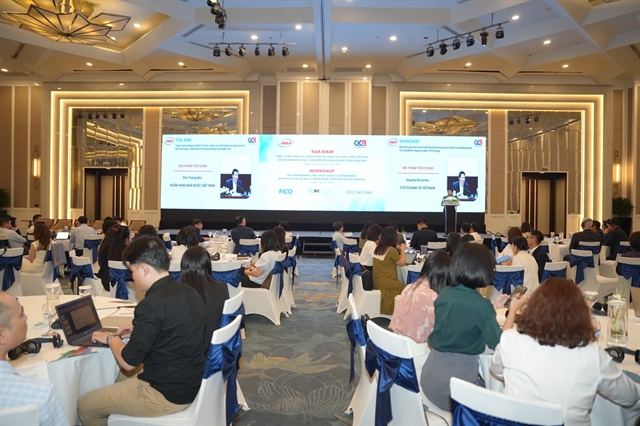
Thu Hà
HÀ NỘI — The application of Artificial Intelligence (AI) and data standardisation are key to improving credit quality and banks' risk management in Việt Nam, officials said at a workshop on risk management and credit quality enhancement in Hà Nội on Wednesday.
The event focused on the use of technology for risk management and enhancing credit quality with new credit rating and scoring models.
Deputy Governor of the State Bank of Vietnam (SBV) Phạm Tiến Dũng said that the Politburo has issued Resolution 57 to promote digital transformation in the country, and the banking industry has applied technology to cut costs and implement online lending.
“The application of digital technology is an inevitable trend. Any bank that does not apply digital solutions in assessing risks, giving customers credit scores and disbursing online loans on technology platforms will be left out of the game,” Dũng said.
Vice Chairman and General Secretary of the Vietnam Banks Association Nguyễn Quốc Hùng told the conference that in the context of a volatile economy, ensuring credit safety and improving risk management efficiency are increasingly important factors in the operations of credit institutions, especially commercial banks.
In parallel, the rapid development of technology — especially AI, machine learning and big data analysis — is opening up new opportunities to optimise the credit scoring process, increase the accuracy of risk assessment, and improve the quality of credit portfolios.
“Over the years, we have witnessed the strong development of credit risk management tools in Việt Nam, from building internal credit rating systems to applying advanced international governance standards according to Basel II and Basel III,” Hùng said.
According to Hùng, to ensure system safety and meet international standards and practices, the SBV has thus far issued several regulations related to the internal credit rating system.
Some of the most recent regulations include Circular 31/2024/TT-NHNN dated June 30, 2024, on the classification of assets in the operations of commercial banks and non-bank credit institutions, and Circular 14/2025/TT-NHNN dated June 30, 2025, regulating capital ratios for commercial banks and non-bank credit institutions.
Under these rules, credit institutions must develop an internal credit rating system to rank customers as a basis for credit approval, credit quality management and risk provisioning policies appropriate to the scope of operations. To date, all large credit institutions have created their own internal credit rating systems.
However, Hùng noted, the current credit rating and scoring models of credit institutions still have several shortcomings.
“Financial data for many customers has not been disclosed transparently and clearly, except for public companies, while there are few connected information data systems for direct verification," Hùng said.
"Important data, such as for tax, social insurance, customs and telecommunications, has not been exploited, causing incomplete and inaccurate scoring and ranking results,” he added.
He went on to state that the internal credit rating system of some new credit institutions also uses only traditional data instead of non-traditional data to rate customers.
In addition, criteria for scoring and rating customers' credit at some institutions are not strict, or are not in line with market standards and practices, which poses significant risks for credit institutions.
“Due to the transformation of the digital economy, changes in consumer behaviour and diversification of credit types, there is an urgent need for new methods and tools to assess risks with higher speed and reliability. The application of modern credit rating models based on new technology platforms not only helps credit institutions make more accurate credit decisions, but also contributes to improving competitiveness and adapting to increasingly strict management requirements from supervisory agencies,” Hùng said.
At the workshop, Phạm Thị Thanh Huyền, a senior expert from the International Finance Corporation (IFC), said that banks in Việt Nam are using self-collected data to score credit. The IFC therefore recommended that the Credit Information Center (CIC) should be a focal point to build a common credit scoring model for the entire banking industry.
Meanwhile, CEO of Nice Info Vietnam Chun Henry Hyunwoo explained that in Korea, a limited number of non-bank-defined institutions currently apply third-party corporate ratings like the Credit Risk Index for regulatory tax calculations, but the majority rely on their internal R&D models.
In Việt Nam, the R&D framework has not yet been fully implemented. At this point, CIC's credit model can play a central role in credit risk assessment and serve as a reliable and practical foundation for both regulatory compliance and day-to-day operations, Chun said.
“Given this context, it is important for banks and financial institutions in Việt Nam to actively utilise CIC's core and corporate information for the development of their own internal rating system in the future," he said.
"As a regulatory framework becomes clear, institutions may begin to adopt additional models in line with the supervisory guidelines. When that time comes, additional models, such as strategic and regional models, may serve to complement R&D-based approaches in areas not fully covered by regulated models."
According to Chun, during this transitional period, every new CIC-established scoring system and dataset will be essential, both for the day-to-day credit decision making and as a foundation for future model development. — BIZHUB/VNS
- Tags
- banking





